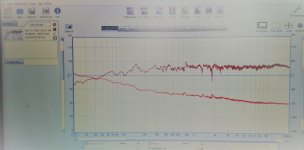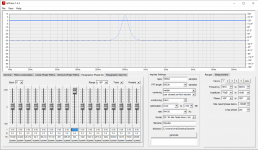I assume the network is there to manage those phase changes, and does, unless otherwise stated. So I'll try again..Crossovers are indeed evil things, most of them producing unwelcome phase changes,
I agree that a crossover is a problem, because the drivers are not in the same space. Define this problem and you will know what your filters can and should do, you'll answer your own question. There is a limit to thinking that a filter of any kind can change this situation.
I'm still not convinced three way is a good thing in general though, and I swore I'd never make another one...
The pioneer's certainly didn't, at least for 'full-range' systems. Two way XO'd between 300-800 Hz and their optimal conclusion for the speech BW was a ~70-7 kHz 8" tri-flex with mechanical XOs to sonically sound as a three way point source.
Ditto.
Best passive speakers I've ever heard, and I'm not alone in the view, was the EPOS ES14.
The "crossover" was a capacitor to protect the tweeter.
In the analog realm, every component between source and listener degrades the sound. One minimises them.
What has changed the game is the digital realm. So long as what you are messing with stays digital, you have complete freedom.
In theory. I've never gone near DSP, because the idea of having an ADC after my Linn is anathema. However, these days I'm mainly streaming Amazon HD, so why not DSP? I'll see how it pans out.
I'm currently planning to have both a DSP and a conventional active crossover, switching according to whether the source is digital or analog. We shall see.
The "crossover" was a capacitor to protect the tweeter.
In the analog realm, every component between source and listener degrades the sound. One minimises them.
What has changed the game is the digital realm. So long as what you are messing with stays digital, you have complete freedom.
In theory. I've never gone near DSP, because the idea of having an ADC after my Linn is anathema. However, these days I'm mainly streaming Amazon HD, so why not DSP? I'll see how it pans out.
I'm currently planning to have both a DSP and a conventional active crossover, switching according to whether the source is digital or analog. We shall see.
I'm finding myself arguing against my own speaker but:
Crossovers are indeed evil things, most of them producing unwelcome phase changes, and passive ones are very hard to tweak. Designing speakers with a three way passive crossover is a nightmare, and you end up spending a fortune on changing bits. ...
The crossover is your friend, not enemy. The real enemy is the physical device you planned and built, xo mission is to blend all of it together as good acoustic output.
Modern design tools like VituixCAD take all the voodoo out from xo design and will reveal how your loudspeaker behaves acoustically. Altough one has to learn how to take meaaurements and practice a bit to trust them, the rest is matter of tweaking and if it looks like xo doesnt fix issues it is time to revisit the physical object you have built. In case of passive xo there are some aspects here knowledge helps but you can always ask in the forums for help. Parts bucket should minimize considerably from the old days. Sims with proper set of "spinorama" measurements will also show the mismatch between 6" and 1", among all else you need to know about your speaker. As always, few prorotypes, critical thinking, tinkering and testing will take to better results. DSP is faster to tweak but the build, measurement and sim phase are pretty much the same as with passive parts. Have fun! 🙂
Last edited:
I've got the tools to design the perfect crossover in theory, but in practice you have to tinker. And that's expensive and time consuming with passive crossover, merely time consuming with active crossovers and I am HOPING a doddle with DSP (which I have never used before). We'll see!
We can do delay passively (not that all speakers need it), change phase alone, fine EQ and precise filtering. What else?
Linear acoustical phase response (without phase wrap) with high order crossover slopes.
acampm:
Crossovers are indeed evil things, most of them producing unwelcome phase changes...
Sometimes you can make speaker with ruler flat fr response and almost perfect phase response if you select great drivers, with simple crossover.
Here is such example:
Audio Pages: MTM with Vifa 13WH-00-08 and AMT tweeter
Crossovers are indeed evil things, most of them producing unwelcome phase changes...
Sometimes you can make speaker with ruler flat fr response and almost perfect phase response if you select great drivers, with simple crossover.
Here is such example:
Audio Pages: MTM with Vifa 13WH-00-08 and AMT tweeter
Attachments
Last edited:
acampm:
I'm still not convinced three way is a good thing in general though, and I swore I'd never make another one...
Building 3-way and 4-way speaker only these days. 2-way has too many compromises. Just grow up.
I'm still not convinced three way is a good thing in general though, and I swore I'd never make another one...
Building 3-way and 4-way speaker only these days. 2-way has too many compromises. Just grow up.
I'm going 3-ways these times, but it's a choice...
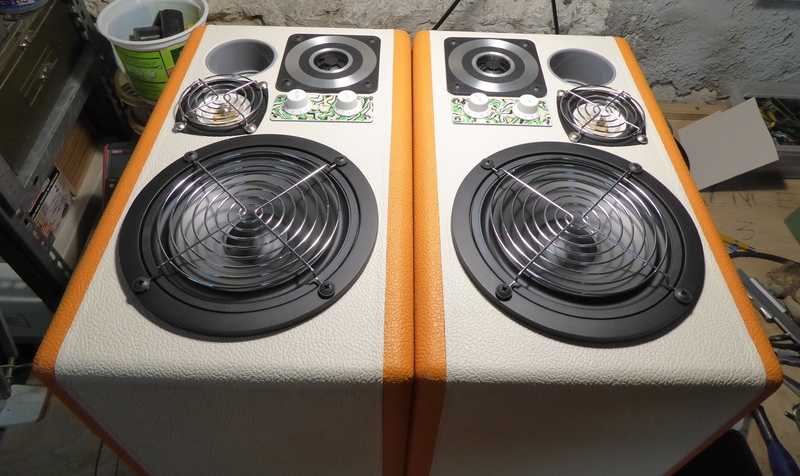
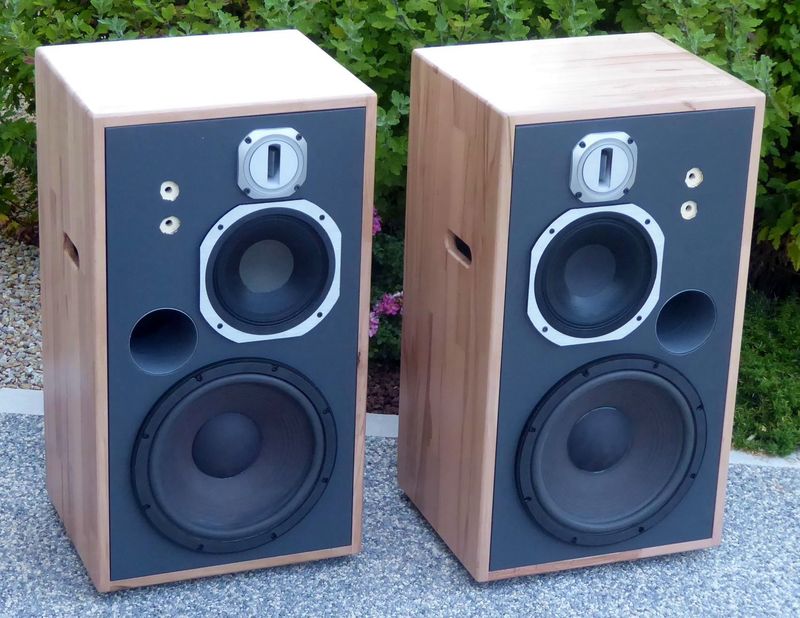
And I'll second @tmuikku : The crossover is your friend, not your enemy. In the sense that simplicity is not better than complexity and vice-versa.
One example - for my little CUBE 2-way speakers (200x200x200mm) :

I first started with simplicity : a 6dB/oct 4.5KHz Xover. The distance between the speakers being very narrow, I counted on the tonal integration at the listening position.
The result was acceptable at 3m for a very critical listening position though, but there were unbearable directivity problems when moving or getting closer a bit, giving tonal changes.
Then I shifted for a 12dB/Oct 4.5KHz L-R Xover :
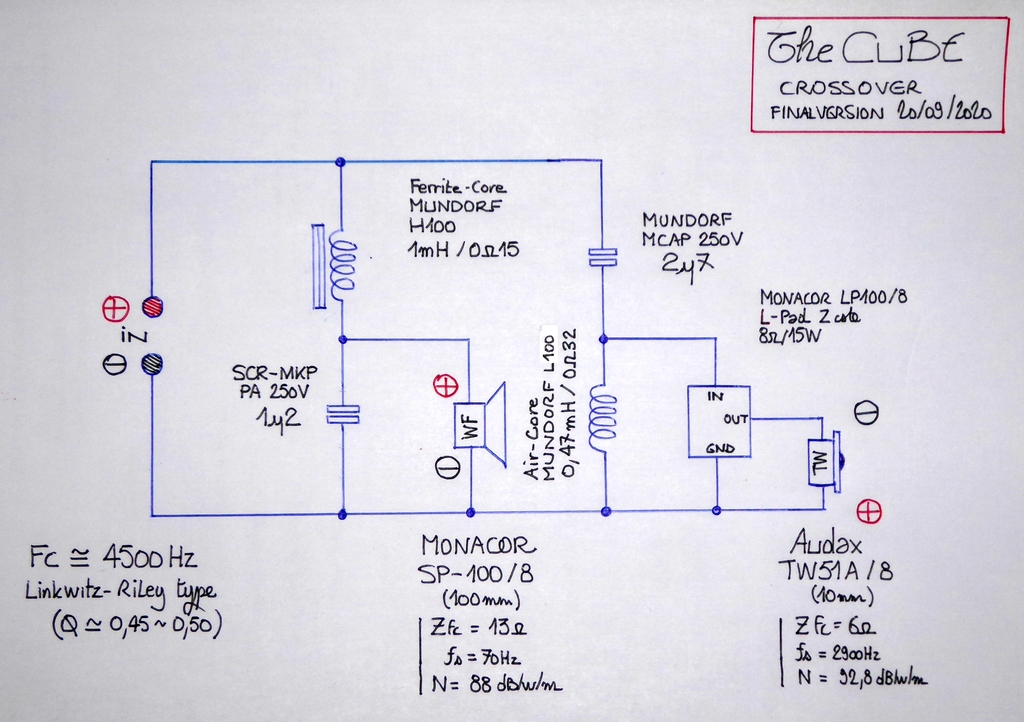
And this solved the directivity and tonal changes problems, plus offering a better "blend" or homogeneity between the speakers.
Simplicity did not worked in this case : it's not a generalization in any way, OK ?
We all know that 6dB/oct. Xover are very demanding to show their ideal qualities, and here, the conditions were not met.
For my bigger 3-way project above, I studied 2 different 3-ways Xover...
A more simpler one :
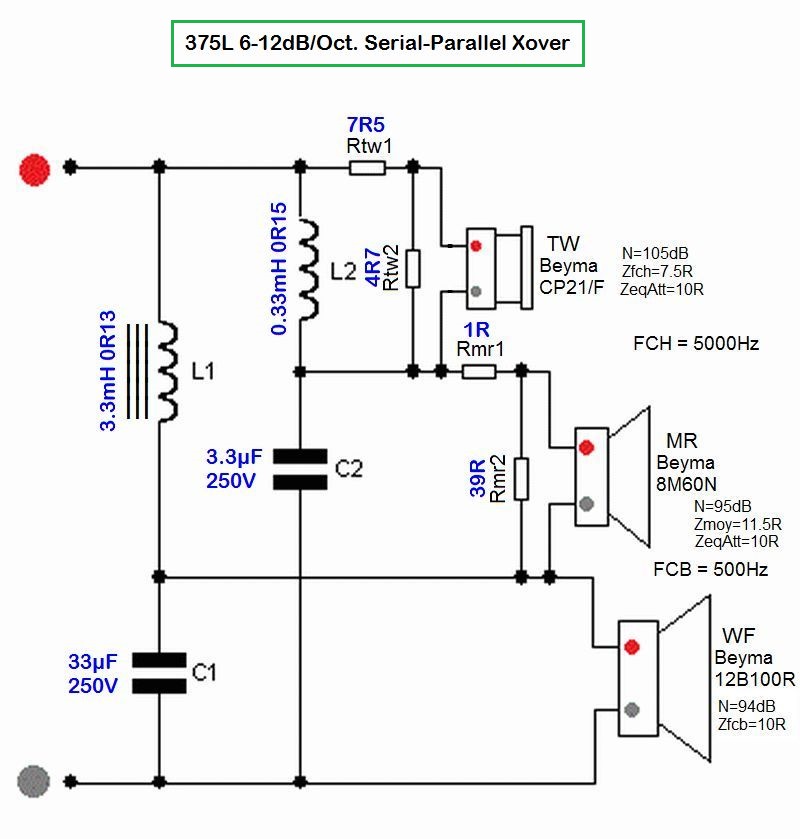
A more complex one :
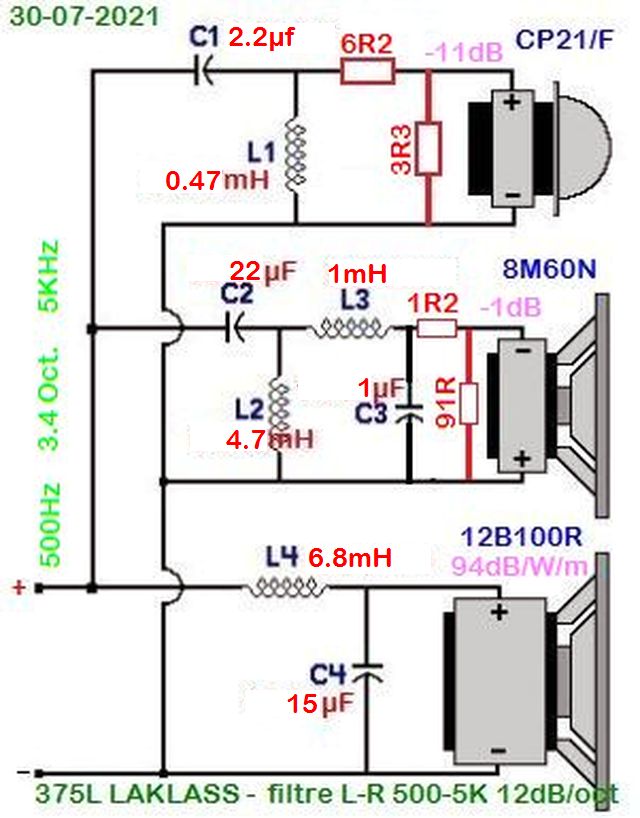
Auditive comparisons well tell me in fine which one is the most suitable for my use - again, no generalization, even if the plus and minus of each formula are indeed well documented...
A+!


And I'll second @tmuikku : The crossover is your friend, not your enemy. In the sense that simplicity is not better than complexity and vice-versa.
One example - for my little CUBE 2-way speakers (200x200x200mm) :

I first started with simplicity : a 6dB/oct 4.5KHz Xover. The distance between the speakers being very narrow, I counted on the tonal integration at the listening position.
The result was acceptable at 3m for a very critical listening position though, but there were unbearable directivity problems when moving or getting closer a bit, giving tonal changes.
Then I shifted for a 12dB/Oct 4.5KHz L-R Xover :

And this solved the directivity and tonal changes problems, plus offering a better "blend" or homogeneity between the speakers.
Simplicity did not worked in this case : it's not a generalization in any way, OK ?
We all know that 6dB/oct. Xover are very demanding to show their ideal qualities, and here, the conditions were not met.
For my bigger 3-way project above, I studied 2 different 3-ways Xover...
A more simpler one :

A more complex one :

Auditive comparisons well tell me in fine which one is the most suitable for my use - again, no generalization, even if the plus and minus of each formula are indeed well documented...
A+!
Last edited:
We can do delay passively (not that all speakers need it), change phase alone, fine EQ and precise filtering. What else?
Allen,
I will pay you £20 to come up with a passive speaker-level filter that produces a phase shift of +170 degrees with Q=5 at 500Hz and zero effect on the frequency response. Simulation in XSim or similar is fine, so long as I can reproduce it at this end.
As far as I know, this cannot be done outside of FIR. I'll happily pay that money for the lesson.
acampm, passive crossovers are much easier when you follow these steps:
- Take good measurements of each drive unit in question, and also a measurement of the overlap area
- Load those measurements into XSim (other crossover simulators are available, but I like that one)
- Design a crossover
- Build the crossover. I try to make my crossovers so that the tonal balance can be adjusted easily by changing a particular component.
- Measure to confirm
- Enjoy
Without good acoustic measurements of your drivers on your baffle, you're flailing around in the dark, and are unlikely to get optimal results.
Thankfully, it's very cheap to get started with measurements. Grab a Behringer UMC202HD and a measurement mic, download REW, and you're on your way.
Chris
Allen,
I will pay you £20 to come up with a passive speaker-level filter that produces a phase shift of +170 degrees with Q=5 at 500Hz and zero effect on the frequency response. Simulation in XSim or similar is fine, so long as I can reproduce it at this end.
Maybe Allen can do it, maybe not... but the real point is this: who would need such a response modification? I can't imagine a real world application.
When Allen wrote that passive filters can alter phase and delay, I understood that to be within the context of normal speaker design requirements. I can understand the need for a 45 degree phase shift with a Q=0.8 ... not 170 degrees with a Q=5.
The rest of your post, Chris, I agree with.
acampm - with good measurements and good simulations, a passive crossover will not need much after-the-fact adjustment. Most of the time, adjustments are made with resistors which are added in series or parallel with various components.
But if you have decided to go the active route, that is fine. I made the same choice. But don't fall into the trap of believing you can ignore good design practices or avoid measuring.
j.
acampm - with good measurements and good simulations, a passive crossover will not need much after-the-fact adjustment. Most of the time, adjustments are made with resistors which are added in series or parallel with various components.
But if you have decided to go the active route, that is fine. I made the same choice. But don't fall into the trap of believing you can ignore good design practices or avoid measuring.
j.
If I had a speaker that required that kind of correction I'd be looking elsewhere and not trying to fix it electrically. 😉I will pay you £20 to come up with a passive speaker-level filter that produces a phase shift of +170 degrees with Q=5 at 500Hz and zero effect on the frequency response.
In any case...
Attachments
Maybe Allen can do it, maybe not... but the real point is this: who would need such a response modification? I can't imagine a real world application.
When Allen wrote that passive filters can alter phase and delay, I understood that to be within the context of normal speaker design requirements. I can understand the need for a 45 degree phase shift with a Q=0.8 ... not 170 degrees with a Q=5.
FIR allows the phase and frequency response curves to be altered arbitrarily and independently.
The numbers I picked are arbitrary. You're correct in saying that those numbers aren't realistic, but that's not my point. My point is that FIR can do this stuff, and passive filtering cannot.
Allen,
An impressive attempt! Certainly more complex than any of my passive crossovers.
However, attached is what the curve ought to look like. The £20 remains on the table if you'd like to try again.
Chris
Attachments
Hmm, now what makes you think that objectively better is not useful?
(..I should also probably note that I'm not "down" on passive crossovers, and that I use DSP to arrive at a final passive crossover. Still, I do note limitations with passive that are beyond that of what can be done with DSP.. and of course that good DSP often relies on equipment that might not be preferable to a good passive design with other better equipment for the final subjective result. I also tend to like what some passive filtering can do to the sound (subjectively) irrespective of the filter itself, and try to avoid where it can subjectively worsen the result as well.)
(..I should also probably note that I'm not "down" on passive crossovers, and that I use DSP to arrive at a final passive crossover. Still, I do note limitations with passive that are beyond that of what can be done with DSP.. and of course that good DSP often relies on equipment that might not be preferable to a good passive design with other better equipment for the final subjective result. I also tend to like what some passive filtering can do to the sound (subjectively) irrespective of the filter itself, and try to avoid where it can subjectively worsen the result as well.)
Last edited:
Tastes are wide, but I listen to a lot of loud rock in a very big room.
3-way (or more).
Given your taste in music I'd start with the Eminence Kapplite 3012LF, and plan a low-pass around 300-400 Hz relative to floor bounce and your listening distance. A driver like this can give a good "visceral" result that's particularly well suited to loud rock.
From there I'd look to midranges and tweeters of choice, with the understanding that you want your midrange to extend down to that 300-400 Hz range.
Tastes are wide, but I listen to a lot of loud rock in a very big room.
Please define 'large' as so far all the suggestions equate to small-medium size IME.
- Home
- Loudspeakers
- Multi-Way
- Two or three way?
